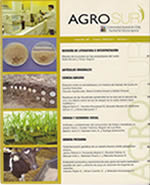Carga ganadera y capacidad de carga de los pastizales naturales de la Patagonia chilena: estimación a nivel comunal
Contenido principal del artículo
Resumen
Se efectuó un estudio para determinar la intensidad relativa de uso de la explotación ganadera, mediante el cuociente entre la carga ganadera y la capacidad de carga de los terrenos con aptitud pastoral de las regiones de Los Ríos, Los Lagos, General Carlos Ibáñez del Campo (Aysén) y Magallanes y Antárctica Chilena (Patagonia Chilena). Mediante información del Censo ganadero del año 2007 y cruces de cobertura referidas a terrenos de pastoreo con aptitud pastoral a nivel comunal, se determinó la carga ganadera actual, la cual se comparó con la capacidad de carga. Esta última variable fue calculada a partir de la producción promedio anual de MS de los pastizales, la que se estimó a nivel regional mediante un modelo basado en una serie de 10 años de imágenes NDVI-MODIS con un tamaño de pixel de 6,25 ha aproximadamente. Los resultados preliminares de este análisis indican que los pastizales de la patagonia chilena presentan alta variabilidad espacial en cuanto a su producción anual de MS. Las regiones de Los Lagos y de Los Ríos presentan la mayor densidad animal, evidenciando en ellas el mayor grado de intervención antrópica, lo que en muchos casos se traduce en una situación de sobrepastoreo, contrariamente a lo que sucede en muchas comunas de la región de Aysén. Al respecto, la Región de Magallanes presenta grados de utilización cercana al óptimo, aspecto que debe tomarse con precaución ya que las estimaciones del modelo PMSA vs NDVI en matorrales y coironales al parecer son menos verosímiles.

